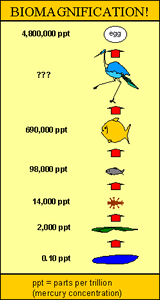| << Chapter < Page | Chapter >> Page > |
Biomagnification represents the processes in an ecosystem that cause greater concentrations of a chemical, such as methylmercury, in organisms higher up the food chain. Mercury and methylmercury are present in only very small concentrations in seawater; however, at the base of the food chain algae absorb methylmercury. Then, small fish eat the algae, large fish and other organisms higher in the food chain eat the small fish, and so on. Fish and other aquatic organisms absorb methylmercury rapidly but eliminate it slowly from the body. Therefore, each step up the food chain increases the concentration from the step below (see Figure Biomagnification ). Largemouth bass can concentrate methylmercury up to 10 million times over the water concentration and fish-eating birds can concentrate it even higher. Other chemicals that exhibit biomagnification are DDT, PCBs, and arsenic.

Other water pollutants include sediment and heat . Muddy water is bad for drinking but even worse for underwater plants that need sunlight for photosynthesis. Much of the sediment in water bodies is derived from the erosion of soil, so it also represents a loss of agricultural productivity. Thermal pollution involves the release of heated waters from power plants and industry to surface water, causing a drop in the dissolved O 2 content, which can stress fish.
Hard water contains abundant calcium and magnesium, which reduces its ability to develop soapsuds and enhances scale (calcium and magnesium carbonate minerals) formation on hot water equipment. Water softeners remove calcium and magnesium, which allows the water to lather easily and resist scale formation. Hard water develops naturally from the dissolution of calcium and magnesium carbonate minerals in soil; it does not have negative health effects in people.
Groundwater pollution can occur from underground sources and all of the pollution sources that contaminate surface waters. Common sources of groundwater pollution are leaking underground storage tanks for fuel, septic tanks, agricultural activity, and landfills. Common groundwater pollutants include nitrate, pesticides, volatile organic compounds, and petroleum products. Polluted groundwater can be a more serious problem than polluted surface water because the pollution in groundwater may go undetected for a long time because usually it moves very slowly. As a result, the pollution in groundwater may create a contaminant plume , a large body of flowing polluted groundwater (see Figure Contaminant Plume in Groundwater ), making cleanup very costly. By the time groundwater contamination is detected, the entity responsible for the pollution may be bankrupt or nonexistent. Another troublesome feature of groundwater pollution is that small amounts of certain pollutants, e.g., petroleum products and organic solvents, can contaminate large areas. In Denver, Colorado 80 liters of several organic solvents contaminated 4.5 trillion liters of groundwater and produced a 5 km long contaminant plume. Most groundwater contamination occurs in shallow, unconfined aquifers located near the contamination source. Confined aquifers are less susceptible to pollution from the surface because of protection by the confining layer. A major threat to groundwater quality is from underground fuel storage tanks . Fuel tanks commonly are stored underground at gas stations to reduce explosion hazards. Before 1988 in the U.S. these storage tanks could be made of metal, which can corrode, leak, and quickly contaminate local groundwater. Now, leak detectors are required and the metal storage tanks are supposed to be protected from corrosion or replaced with fiberglass tanks. Currently there are around 600,000 underground fuel storage tanks in the U.S. and over 30% still do not comply with EPA regulations regarding either release prevention or leak detection.

Notification Switch
Would you like to follow the 'Sustainability: a comprehensive foundation' conversation and receive update notifications?